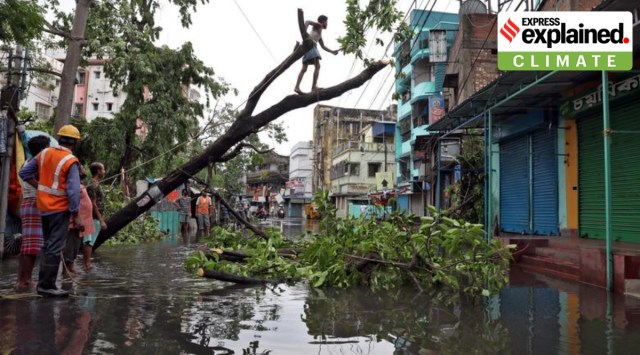Super cyclones in India, Bangladesh: numbers exposed to severe flooding projected to rise hugely
The research, led by the University of Bristol and including scientists from Bangladesh, looked at the 2020 Super Cyclone Amphan, the most costly cyclone to have made landfall in South Asia.
 A man cuts branches of an uprooted tree after Cyclone Amphan made its landfall, in Kolkata, India, May 21, 2020. (Reuters Photo/File)
A man cuts branches of an uprooted tree after Cyclone Amphan made its landfall, in Kolkata, India, May 21, 2020. (Reuters Photo/File)A new study has found that super cyclones are likely to have a much more devastating impact on people in South Asia in future years. The paper was published in the Royal Meteorological Society journal Climate Resilience and Sustainability on Monday — a day when the India Meteorological Department was tracking Asani, classified as a severe cyclonic storm and predicted to weaken into a cyclone.
The research, led by the University of Bristol and including scientists from Bangladesh, looked at the 2020 Super Cyclone Amphan, the most costly cyclone to have made landfall in South Asia. They projected its consequences in different scenarios of sea level rise due to global warming.
FINDINGS: The researchers used sophisticated climate model projections to anticipate the scale of those affected by cyclones in the rest of this century. They found that if the release of greenhouse gases into the atmosphere continues at the same scale, more than two-and-a-half times (250%) the population in India, as compared to the 2020 event, would experience flooding of greater than 1 metre.
In Bangladesh, the increase in the number of people at risk is anticipated to be more modest — a rise of 60% to 70%. This, however, factors in declining coastal populations in future.
If the Paris Agreement climate goals of 2°C warming above pre-industrial levels are adhered to, the modelling showed, population exposures to flooding would drop close to zero in that country. But in India, even in this scenario, the exposures still showed an alarming increase — between 50% to 80% more people compared to 2020 are expected to experience flooding in future.
TAKEAWAYS: The study “presents a critical piece of evidence in support of ramping down our greenhouse gas emissions to achieve the Paris Agreement climate goals, where other lines of evidence all too often focus on high income countries where impacts are lower, and adaptation is more easily achievable”, lead author Dann Mitchell, Professor of Climate Science, was quoted as saying in a media release from the University of Bristol.
Saiful Islam, Professor of Hydrology at the Bangladesh University of Engineering and Technology, and contributing author of the study, was quoted as saying: “… a strong, rapid and sustained greenhouse gas reduction is essential to achieve goals of the Paris Agreement and to reduce losses and damages of highly vulnerable countries like Bangladesh.”
PAPER: Dann Mitchell et al, ‘Increased population exposure to Amphan-scale cyclones under future climates’, Climate Resilience and Sustainability. rmets.onlinelibrary.wiley.com/doi/full/10.1002/cli2.36
Newsletter | Click to get the day’s best explainers in your inbox
- 01
- 02
- 03
- 04
- 05






































